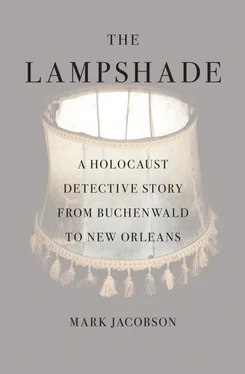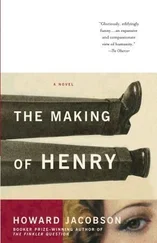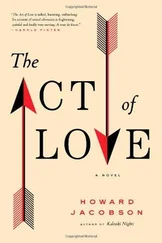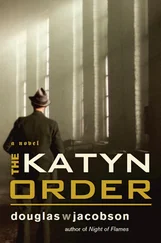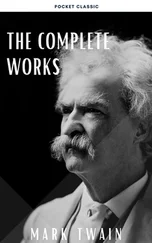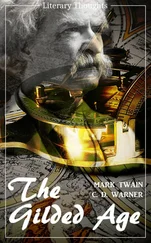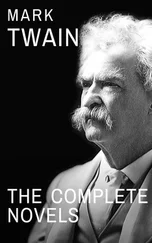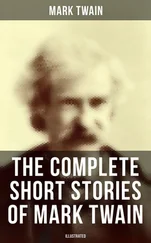Looming above it all was the wall, what is euphemistically known as the “West Bank Separation Security Barrier.” Projected to stretch more than four hundred miles when finished, twenty feet high in some spots, with Sing Sing—style watchtowers, the wall was shockingly awful, a far more formidable and depressing presence than one might imagine from reading the New York Times . Plotted along the jagged, gerrymandered Green Line, one minute the wall was in front of you, the next it was behind. It surrounded you. If graffiti is defiance, there was plenty of that. Somewhere near East Jerusalem, “CTRL + ALT + DELETE” was scrawled in ten-foot-high letters, as if cosmic reboot were the only solution.
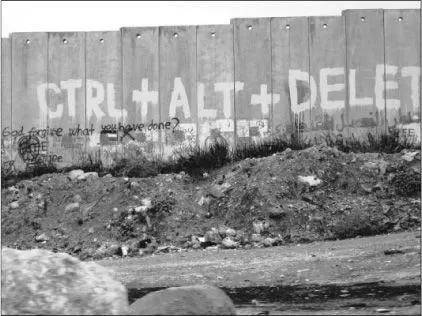
Farid and I drove through this ravaged zone talking of the lampshade. The lampshade story was “incredible,” he said, yet here, on the edge of Ramallah, it made perfect sense to him.
“You know, I have visited Yad Vashem. Some years ago, as an Israeli Arab, a secular man, a nonpolitical man. I thought it the right thing to do.” Farid described how he went through the exhibits, seeing “the terrible, terrible things the Germans did to the Jews.” One thing that stuck with him was “how, in the end, after you have been through all that misery, you come out onto a patio where there is a fine view of the countryside. It was as if to say, we have suffered, the Jewish people have suffered the worst crimes, yet here is the reward, what God has promised us: the State of Israel, a land of milk and honey. What I want to know is, where is the Palestinian reward for this suffering? Where is our view of the Promised Land? This wall?
“People are always asking me how the Jews can act in such a way after what the Germans did to them. How can they do this to us? I understand what they are saying, but what gives anyone the idea that being brutalized teaches people not to brutalize others? It is too bad, but this is not human nature.”
Farid said he often saw graffiti in which swastikas were painted inside Stars of David. “This is a tragedy. It is wrong to equate these two circumstances. But this is a violent place; the parents are disaffected. The children grow up angry, confused. When I hear them say the Jews are Nazis, I say calm down, I have been in this country my whole life, dealing with Israelis since birth. I have many good friends. The goal is to stay rational, do your job, provide some help. It can be a trying experience.
“But when you bring up this lampshade—making a lampshade out of a human being—this is an act of gratuitous cruelty. It is outside the general program. It is terror. Sheer terrorism. It makes me think of the stories one hears from Lebanon, the reports that the IDF places bombs inside of toys, which explode when the children pick them up. This is a similar thing.”
I had heard these same stories, how bombs were secreted by Israeli forces inside soccer balls and dolls, but I thought that they had been proven to be false, a bit of heavy-handed propaganda.
“I didn’t say this was positively true,” Farid replied. “How would I know? I am not there. I am only saying that this is what many people believe. It is difficult to stand in the way of that. You know how these rumors start and become more powerful than the truth.”
The ride back to Jerusalem was quick. It is barely a half-hour drive from Ramallah back to Jerusalem, and with Farid’s blue teudat zehut ID card, getting through the checkpoints was a breeze. If his ID were green and his car had a Palestinian license plate, the same trip could have taken hours, if we’d have gotten through at all. “Another benefit of neutrality,” Farid said.
• • •
Back at the hotel I fell asleep in my clothes before the sun went down and woke up at three in the morning, sweaty and jangled. The situation called out for Xanax but the six-foot walk to the bathroom seemed way too strenuous. I stayed in bed, scanning the room. I could see the lampshade sitting on the desk beside the television cabinet: Ziggy, in his snow white box, the crimson handle grayish in the gloom.
At Yad Vashem they wanted “provenance and dating,” but this was a dodge; there was no way I would ever be able to trace the lampshade back to a specific concentration camp at a specific time. I had asked Yehuda Bauer if the murders of Ed Gein could be connected to the Holocaust, if the Wisconsin fiend got the idea to make human skin lampshades from reading articles about Ilse Koch. The professor said it would be “a persuasive argument.” Not that this sort of cultural studies analysis was likely to pass museum muster. It was fine to adhere to strict standards of provenance and dating, but museums made mistakes all the time; the Museum of Natural History in New York had the wrong head on the Apatosaurus skeleton for fifty years. Besides, why should the lampshade be subject to more stringent proofing than some of the most famous pilgrimage spots in Jerusalem?
It was a city of fakes, full of the unreliable, the unprovable.
One afternoon I went up to the Chamber of the Holocaust, a small museum on Mount Zion at the southern edge of the Old City, where I’d been told they had a lampshade on display. Among the first assemblages of Shoah-related objects in Jerusalem, the “Chamber” lived up to its name. A dank series of cavelike rooms below an Orthodox yeshiva, the place had a musty, subterranean feel, as if the Golem were crouching in the next passageway.
“You want what?” came the voice from behind me. It was Aharon S., a pasty-faced man wearing the sort of wide-brimmed fedora usually associated with the Lubavitch Hasidim. Formerly of Brooklyn, Aharon, who could have been any age under fifty, identified himself as “the only watchman and curator” currently employed by the Chamber of the Holocaust. I asked him if he had a lampshade in his collection.
“We don’t have the lampshade. We have the soap.”
“You have soap?”
“Soap from Jews. Soap and ashes. From the Holocaust. It is in there.” He put down the old-style heavy black telephone receiver he’d been screaming into and pointed to the dark hallway leading to the exhibit halls. “I cannot accompany you to the soap. You will have to go alone. I can’t go into that room. I am a Kohen .”
This meant that, as a Jew whose patrilineal line could be reputedly traced back to Moses’s brother Aaron, Aharon was a member of Judaism’s priestly caste, descended from those who were thought to have conducted services in the Temple. The Kohanim are subject to a vast number of rules and practices aimed at preserving ritual purity, including a prohibition of proximity to the dead. They must not touch the deceased or enter any space in which a dead body or part of a dead body may be found. [23] In the middle 1990s, Professor Karl Skorecki and his collaborators established the existence of the “Cohen Modal Haplotype,” a DNA configuration thought to be distinctive to descendants of Aaron, brother of Moses, the first Kohen Gadol (high priest) of the twelve tribes of Israel. Since then many Jews, in both America and Israel, have undergone DNA testing to see if their particular arrangement of Y chromosomes qualifies them as Kohanim, or members of the priestly class. “Not everyone is Kohanim, but lots of people wish they were,” said Rabbi Yaakov Kleiman when I talked to him in a café not far from his house in the Old City of Jerusalem. Author of a number of books on the topic, including DNA and Tradition: The Genetic Link to the Ancient Hebrews, Rabbi Kleiman, a Kohen himself (and a big Dr. John the Night Tripper fan), sees the discovery of the priestly gene as a powerful linkage between modern Jews and those of biblical times. “Jews have spent so much time and effort debating who is a Jew and who isn’t. Now science is helping us, making some of the decisions for us. We’re living in the golden age of Jewish population genetics,” Rabbi Kleiman said. “I think that fifty years ago, if you had asked a Jew, especially a Jew in Israel, if it was possible to trace their origin straight back to Aaron, they would have looked at you like you were nuts. Now we can. Perhaps that explains a lot of recent history, because when suddenly things you think will always be hidden are suddenly revealed, that changes a lot.”
Читать дальше
